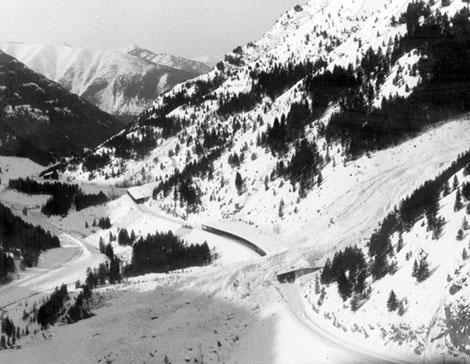Long after the public comment period closed on Glacier National Park's draft environmental impact statement regarding a railroad's request to bomb avalanche chutes on the park's southern boundary, the railroad apparently has succeeded in tweaking that document.
National Park Service officials are playing down Burlington Northern Santa Fe Railroad's success in changing the wording in the DEIS, saying it was only for clarification and not to alter the park's preferred alternative to prohibit the bombing. But the National Parks Conservation Association's Montana office was concerned enough to file a Freedom of Information Act request to see just what influence the railroad had and what changes were made.
“Only BNSF and the park know what these changes are," Will Hammerquist, who runs NPCA's Glacier office, told the Traveler when asked why the FOIA request was necessary. "It’s in a situation of ‘take our word for it.’ It’s the position of NPCA that there should be a public disclosure here. There should be a public process and sunshine into how the Park Service arrived at this decision to ‘tweak’ the preferred alternative."
It's possible that the only changes made were to clean up the document. However, the long delay by the Park Service to move the DEIS toward a final EIS raises concerns. Too, the fact that BNSF was able to influence the DEIS wording seems odd in light of the railroad's decision in January 2007 to "formally abandon its proposal and withdraw from the NEPA process."
Burlington Northern officials, in the wake of a 2004 avalanche that caused a derailment along Glacier's southern border, initiated the park's production of the EIS after seeking permission to lob 105 mm explosives at key avalanche chutes in the area of Scalplock, Running Rabbit, Snowslip and Mount Shields mountains in John Stevens Canyon along Glacier's southern boundary.
Snowsheds along the tracks long have been used by railroads to shield trains from slides, but the use of explosives is seen as considerably less expensive than maintaining the sheds. With freight trains running daily past Glacier, hauling upwards of 33,000 container cars a day to and from the Northwest, this section of track is a key route to keep open for commerce. Just the same, the landscape targeted for bombing by the railroad is inside a national park and home to grizzly bears, mountain goats, wolverines, wolves, bald eagles, and other wildlife.
After considering more than 12,000 public comments and deciding that the use of explosives would not be in the best interests of the park's resources or hikers who might come upon unexploded ordnance, Glacier officials last summer issued the DEIS that turned down the railroad's request. The DEIS passed through the Park Service's Intermountain Regional Office in Denver and headed to Washington, D.C., where a "notice of availability" of the "final" EIS was to be published in the Federal Register. Under typical procedures, 30 days later a record of decision implementing the FEIS would have been signed by Intermountain Regional Director Mike Snyder.
But top Park Service officials apparently stalled that process in the wake of pressure by Burlington Northern officials. After setting for months in the office of Deputy Park Service Director Dan Wenks, the DEIS was shipped back to Denver earlier this year for some tweaking. In mid-March, Regional Director Snyder sat down with two of the railroad's top lawyers, as well as its vice president for northern operations, to discuss the document. Also in attendance were Mary Riddle, Glacier's environmental protection and compliance officer, and Wendy Ross, the EIS team leader.
Park Service officials declined Friday to release the exact wording of changes made to the DEIS, saying it was still going through the process and not a public document. However, the changes apparently focus on language in the preferred alternative that called for BNSF to construct snowsheds along five active avalanche paths, as well as a contradiction in the document regarding the use of explosives; one section evidently prohibited their use, while another would allow them under "emergency situations."
In the first instance, since the Park Service can't tell the railroad how to maintain its tracks, BNSF wanted the directive about building snowsheds removed. In the second, the contradiction supposedly was remedied.
Too, according to Ranger Riddle, the DEIS referred to threatened or endangered species using the landscape in question, and since that document was initially prepared some species, including bald eagles, have been delisted and so that section needed to be reworded.
BNSF officials Friday wouldn't comment about the March meeting with Regional Director Snyder or their concerns with the DEIS's wording. Rather, they said that, "We recognize the significance of Glacier National Park and the importance of conservation of this natural resource. Through (the Great Northern Environmental Stewardship Association), an environmental stewardship program that we've been involved with, and through other means, BNSF has demonstrated its commitment to preservation of the unique features of Glacier Park and we believe that it's possible to balance conservation efforts with the protection of human life and protection of vital transportation services. We are committed to working with the park to achieve that balance."
Back at NPCA, Mr. Hammerquest denigrated the railroad's actions, saying BNSF, since formally dropping its request in January 2007, "was actively trying to nullify this public process and go around the public and go around the legal process and have their desires imposed.”
An exact figure for the cost of the EIS process is not yet available, although Ranger Riddle estimated that it wouldn't surpass $500,000. While the cost of preparing an EIS usually falls to the party whose request spurs production of the document, Burlington Northern, which reported gross revenues of $15.8 billion in 2007 and a net income of $1.8 billion, contributed only $240,000. Ranger Riddle said the railroad wasn't billed for the entire cost because both it and the Park Service are members of the Great Northern Environmental Stewardship Association and so it seemed reasonable to share the cost.




Add comment